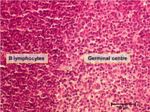T cells
B Cells
Also called B lymphocytes
So named as they were initially found in the Bursa of Fabricius. They produce antibodies (Ig’s) and are associated with humoral immunity. They represent 20-30% of circulating lymphocytes. B cells have B cell receptors (BCR), or antigen binding sites. This is IgM when the B cell is immature, changing to IgD when the cell is mature. B cells also express MHC II, CD9, CD,19, CD20 and CD24.
Under antigenic stimulation they differentiate into plasma cells and memory cells.
B-cells also act as Antigen-Presenting Cells (APCs) by presenting digested fragments to T-cells on MHC II.
For more on B cell differentiation, see here.
Natural Killer (NK) cells
NK cells can be classified as lymphocytes because they are capable of recognising antigen, however they are more often associated with the innate immune response. They target cells by monitoring MHC production, which is expressed by healthy cells to present antigen to T-cells. Low MHC levels can be used as a marker for a cell whose machinery is compromised by a replicating virus. When MHC levels drop, it acts as a danger signal to the NK cells, which then release enzymes to kill the infected cells.
NK cells do not develop in the thymus and represent 5-10% of the circulating lymphocytes. They recognise and kill transformed cells by releasing perforins and granzymes which create channels in the target cell membrane causing lysis. They express the markers CD16, CD56 and CD94.
Natural Killer cells also play a role in Antibody-Dependent Cell-mediated Cytotoxicity
NK Receptors
- Some viruses down-regulate MHC expression of the infected cell
- This is used as a protection against the host immune system
- Lack of MHC inhibits normal T-cell activity
- This is used as a protection against the host immune system
- NK cells can counteract the down-regulation tactic
- They are mainly associated with activity against virus-infected cells and tumour cells, which can also have lowered MHC expression
- The receptors on NK cells do not act like antigen-specific receptors
- Although they trigger functional activity of the cell, they do not stimulate proliferation
- There is no clonal expansion of NK cells
- Although they trigger functional activity of the cell, they do not stimulate proliferation
- NK cells work through two different types of receptors
- Activating receptors, R1
- Recognise pathogen-associated glycolipids or Fc receptors
- E.g. CD16 recognises Ig that is bound to pathogen antigens
- Recognise pathogen-associated glycolipids or Fc receptors
- Suppressing receptors, R2
- Recognise target cell MHC molecules
- Activating receptors, R1
- When an NK cell interacts with a target cell it will be activated via R1
- If the target cell expresses MHC this will be seen by R2
- R2 suppresses the activities of the NK cells
- Therefore, NK cells do not affect normal cells
- R2 suppresses the activities of the NK cells
- If the target cell does not express MHC, the suppressing receptors are not engaged
- Cell activity is not suppressed
- The engagement of R1 therefore causes activation of the NK cells
- Cell activity is not suppressed
- If the target cell expresses MHC this will be seen by R2
When NK cells are activated, they:
- Secrete a range of cytokines, including:
- Tumour necrosis factor alpha; (TNFα)
- A potent stimulator of acute inflammation
- Can cause target cell killing directly and also via stimulated macrophages
- Interferon gamma; (IFNγ)
- Stimulates macrophages
- Active against the target cells
- Stimulates target cell expression of MHC
- Makes target cells susceptible to normal T-cell killing.
- Tumour necrosis factor alpha; (TNFα)
- Initiate killing of the target cell
Lymphocyte Surveillance
About two thirds of lymphocytes (all immunocompetent) are circulating in the blood and lymph systems. Most of these are T cell and long lived. In the lymphatic system they survey tissues. The other third do not circulate and are either short lived or immature, or can be specific cells destined for certain tissues i.e. cells that line connective tissue under the epithelium of respiratory, intestinal and urogential systems.
High Endothelial Venules (HEV) are used for lymphocytes to access the lymph nodes from the bloodstream. Once inside the lymph node, the naive lymphocytes search for antigen. If there is no antigen present, the naive lymphocytes leave via the efferent lymphatic vessel and return back to the bloodstream. Each lymphocyte can search several secondary lymphoid organs each day. This process is called surveillance.
If a naive lymphocyte recognises an antigen then it differentiates into its adult (mature) form. Interdigitating dendritic cells present antigen to T cells and follicular dendritic cells present antigen to B cells.
B cells proliferate into plasma cells in germinal centres, producing antibody.
T cells leave the lymph node in attack mode to locate the infectious organism. The surface molecule L-selectin (which allows the naive lymphocyte to enter the lymph node via an HEV) is replaced by the adhesion molecule VLA-4. At the site of inflammation, the VLA-4 receptor recognises VCAM-1 on endothelial cells and the T cell enters the site of disease. CD4+ T cells search for infected macrophages and CD8+ T cells look for virus infected cells creating an immune response. After the infection has been defeated, memory cells develop which express L-selectin (rather than VLA-4) and continue to search the body in surveillance mode in case the host is re-infected with the disease producing organism.
Additional Resources
Websites
Pages in category "Lymphocytes"
The following 7 pages are in this category, out of 7 total.




